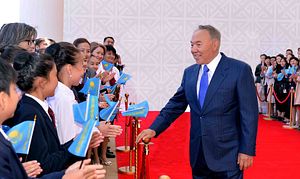A World Bank report released today, “Europe and Central Asia Economic Update: Trade in Transition,” notes that growth across the megaregion stretching from Europe to Eurasia is set to accelerate through 2017, following the slowdown sparked by 2014’s crash in oil prices.
For Kazakhstan, recent developments feed short-term good news but the longer term outlook is predicated on increasingly difficult reforms. Plus, there’s an elephant that goes unmentioned in the report’s section on Kazakhstan: corruption.
According to the World Bank, real GDP growth in Kazakhstan declined from 1.2 percent in 2015 to an estimated to 1 percent in 2016 — in 2013, before the 2014 crash and after recovering from the 2008 financial crisis GDP growth had risen to 6 percent. What’s behind the 1 percent growth rate? On the supply side, the report points to declining oil production and slowing expansion in the services sector, only somewhat offset by increasing output in the agriculture and metallurgy sectors. “Construction also expanded,” the report notes, “due to large projects in the oil sector.” On the demand side, “private consumption weakened considerably due to the passthrough effect of currency devaluation that fueled inflation to 14.6 percent (annual average) and undermined the purchasing power of households.”
The outlook is less dim. Construction in the oil sector — particularly the on-time completion of repairs to Kashagan and its restarting of production — has fed a stabilization of the economy. The World Bank projects economic activity to “pick up gradually over the medium term” but to remain “well below its 2014 level, when the oil price shock hit the economy.” GDP growth is expected to rise from 2.4 percent in 2017 to 2.9 by 2019. Oil prices, the report notes, are projected to increase from $55 per barrel in 2017 to over $60 per barrel in the 2018-19 timeframe. This may be a modest increase but Kazakhstan’s increasing production — thanks in large part to Kashagan getting up to speed — is set to capitalize on it.
At the same time, the Bank expects Kazakhstan’s fiscal position to deteriorate, “due in part to the large banking sector support package approved in early 2017.” The report places hope on the “100 Concrete Steps” — a program of institutional reforms — to “have positive spillovers for private sector development and economic diversification.” Further reforms, including privatization of state-owned enterprises could also mitigate this fiscal deterioration.
The real question is whether the momentum for reform — inspired by bottom-of-the-barrel growth numbers and public protests — can be sustained in Astana as the oil money starts flowing again. It’s cliche to say but Kazakhstan’s vast resource wealth truly is a blessing and a curse. It provided the economic miracle that resurrected the Kazakh economy out of the rubble of the Soviet Union, but that same miracle instilled not just a dependence on resource wealth for growth but helped install pervasive elite-level corruption.
Mention of corruption is notably missing from the risks and challenges section of the report. “Downside risks to Kazakhstan’s economic outlook include the potential weakening of the external environment, capacity constraints, and the loss of reform momentum,” the report notes, followed by “anticipated political transition.”
In their recent book, Dictators Without Borders: Power and Money in Central Asia, Alexander Cooley and John Heathershaw highlight how globalized Central Asia really is, with elites in states like Kazakhstan taking full advantage of the confusing mess that is international finance.
“Not coincidentally, the emergence of this globalized crony capitalism coincided with the region’s worsening authoritarianism,” they write in the introduction, “In Kazakhstan, it was enabled by economic growth on the back of the country’s immense oil and gas wealth coming online.” The bonanza opened opportunities to get rich, particularly among elites — many of whom were not accused of various financial crimes until after they’d fallen out with the regime. The return to a positive economic atmosphere will invariably lead to the same cadres enriching themselves.
So, while the outlook is positive — and will hopefully improve the situation among ordinary Kazakhs — the roots of future crisis remain: lucrative oil revenues and the elites who get rich from them. As Astana enters a slight upturn, it needs to concentrate on pursuing its stated reform package, including taking corruption seriously.

































